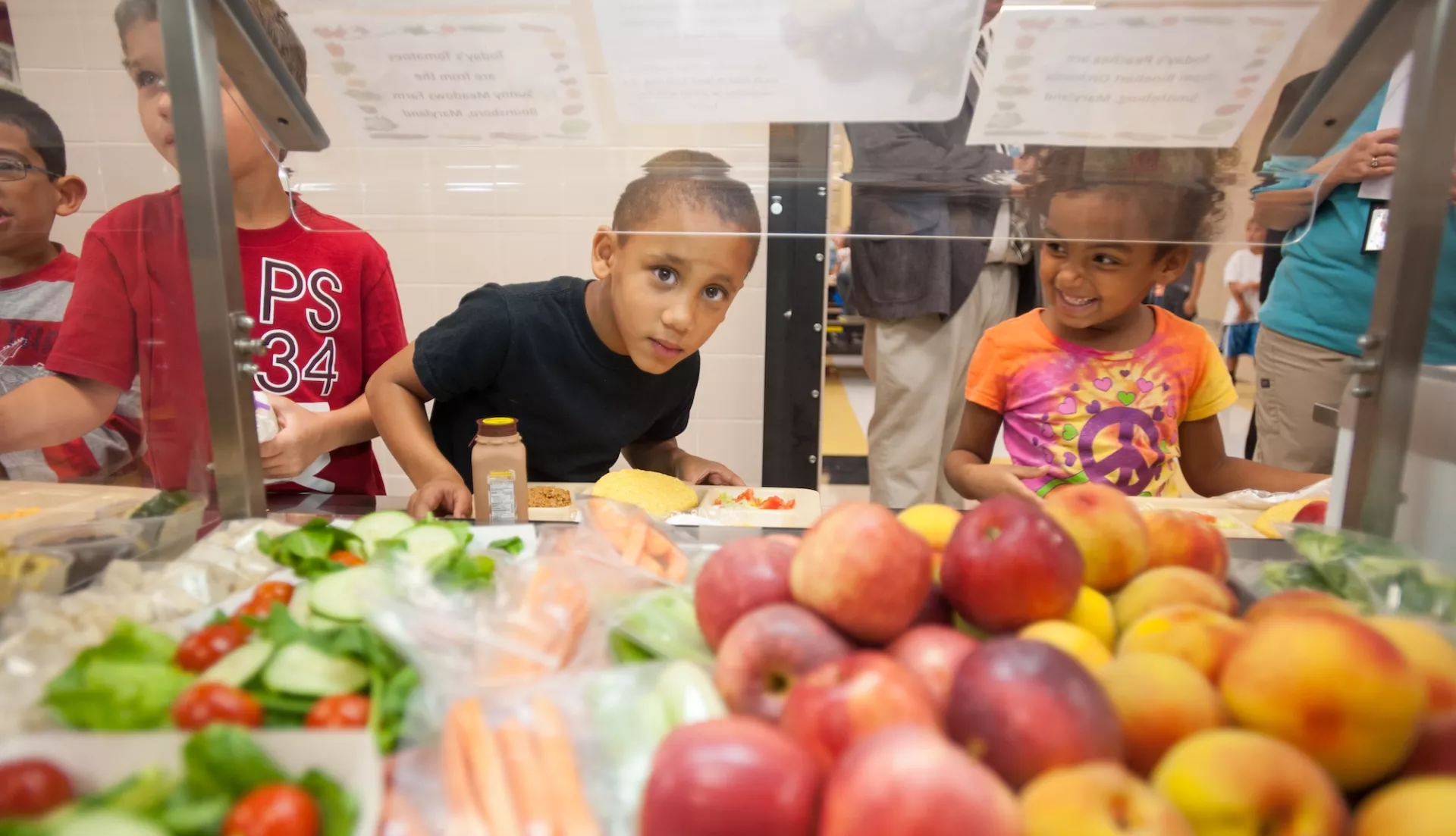Key Takeaways
- Food justice is about communities having access to foods that are affordable, healthy, culturally relevant, and safe.
- Communities of color are more likely to have limited options and minimal access to fresh produce.
Fresh haddock caught off the coast of Maine, smothered in breadcrumbs mixed with parmesan cheese and parsley, and baked at 350 degrees for about 20 minutes. The results? Crunchy baked fish served with mashed potatoes, lemon wedges, and peas. A fresh apple from a neighboring farm accompanies the dish, too.
This entrée could easily be found at a seafood shack anywhere across the country. This one just so happens to be on a lunch tray at Whitefield Elementary School, in rural Maine, where some of the ingredients come from local farmers and fisheries.
Across the country, more school districts are embracing this style of food preparation, known as scratch cooking. They are opting to cook fresh meals in-house, using locally sourced ingredients, and moving away from pre-packaged, processed meals, such as chicken nuggets, pizza, and french fries.
“We have this tremendous potential to reimagine … school meals and drive equity and justice in our communities and across food systems,” says Jennifer Gaddis, an assistant professor of civil society and community studies at the University of Wisconsin-Madison and author of The Labor of Lunch: Why We Need Real Food and Real Jobs in American Public Schools.
Food Justice Explained
Much of this potential comes from a national drive to empower communities, giving them authority over their food supply systems—from what they eat and how they eat it to who provides it to them.
Food justice is when communities have access to foods that are affordable, healthy, culturally relevant, and safe. Plus, they have the power to source local foods; use production methods that invest in the community and are humane and eco-friendly; and create union jobs that pay a living wage as well as offering health and retirement benefits. It’s a tall order, but some districts are making real strides.
Partnerships a Top Ingredient
While apples, blueberries, and broccoli are local favorites in Whitefield, fish is the latest in a growing list of locally sourced foods available to the Sheepscot Valley Regional School Unit 12.
The district has partnered with the Maine Coast Fishermen’s Association to make the catch of the day available to school children. Every week, the district’s school nutrition director, Michael Flynn, drives about an hour to Portland Harbor to get fresh fish right off the boat. He loads about 70 pounds of it into his car and treks back to help cafeteria staff process it for the week’s menu.

“We’re lucky,” Flynn says. “We have a great network of people, from the superintendent, [school] board directors, educators, and parents to local farmer organizations, the Maine Farm and Sea Cooperative, Foodcorp Maine, and Let’s Go 5-2-1-0, who want ingredients to be wholesome. So therefore, we have the latitude to go for it.”
The go-for-it for him is to keep it simple by gradually stocking school pantries and freezers with local foods.
“It could feel large and scary for most production operations,” Flynn says. “But our goal is to do this … one ingredient at a time, so it’s not as overwhelming.”
What’s on Your Tray?
School lunch programs in the U.S. have been around for more than a century. But it wasn’t until 1946 that a federal lunch program was created, providing government subsidized school meals to K–12 students. These meals came with national guidelines, too, and required the meals to include meat, beans, green and yellow vegetables, citrus fruits, milk, and bread and butter on every tray.
Over time, guidelines loosened, and budgets shrank. This shuffled in an era of mass-produced and overly processed foods—including frozen burgers, fish sticks, and tater tots—that bake in unhealthy amounts of sugar, sodium, and fat.
These quick-to-fix meals are part of the heat-and-serve model—a system that produces meals in a factory and then ships them to schools where they’re reheated and served. This model is not only less nutritious, it also dilutes the food service workforce within schools.
Better Food Service Jobs
Many cafeteria staff who work under the heat-and-serve model are employed for 5 hours or less a day. The work is considered “low-skilled,” and staff are poorly compensated. Plus, they are vulnerable to privatization.
“If schools operated with fresh and locally sourced food, the first positive is better nutrition for students. The second is that the food service system would have to change,” says NEA senior policy analyst Tim Barchak.
He explains that cafeteria staff who work with fresh food would need more hours on the job. The employer would have to invest in professional development for working with fresh food. With more skills, workers could leverage more compensation, and it would be more important to retain trained staff.

Some school officials claim it’s a cost-saving measure to outsource their cafeteria workers to big companies. Not so, says Janna Parker, a policy associate with the National Farm to School Network.
“Districts have the money and capability to provide healthy foods that are local,” she says. “They just choose not to. It could be a bit more difficult, but it’s certainly doable.”
Also doable is for members of Congress to pass the Universal School Meals Program Act of 2021, which would provide healthy school meals at no cost to students.
This would help students develop better eating habits and and ensure that students who are hungry have access to meals, whether or not they qualify for free lunches. The program would also help end the stigma caused by policies that single out students for unpaid meal charges.
Food Justice Is Also About Racial justice
There’s another problem on hand, and it’s rooted in systemic racism. Big corporations are making huge profits from public school meal programs, often to the detriment of students’ health, writes Jennifer Gaddis in the K–12 education journal Phi Delta Kappan.
Take milk, for example. Studies reveal that about 90 percent of Asian Americans and 75 percent of African Americans and Native Americans are lactose intolerant compared with only 20 percent of White Americans.
“If schools operated with fresh and locally sourced food, the first positive is better nutrition for students. The second is that the food service system would have to change,” says NEA senior policy analyst Tim Barchak.
“Yet, there’s a federal policy that mandates milk come with every school meal,” Parker says. “It’s making Black boys and girls and other children of color sick because policymakers haven’t changed their guidance to offer other options.”
Parker explains that communities of color are more likely to have limited options and minimal access to fresh produce. To create a food system that is equitable and based on racial justice, a shift in mindset must occur, she says: “It’s an issue of valuing the lives of People of Color, and when you value people … you want them to have the best.”
__________________________________________________________
How To Bring Healthy Food To Your School
- Start a school and community garden, and invite students, parents, and other community members to help.
- Form coalitions to represent the views of all interested parties, including students, parents, school nutrition staff, education support professionals, teachers, administrators, farmers, and child nutrition advocacy groups.
- Provide professional development to school nutrition and cafeteria staff that covers scratch cooking and knife skills. Remember that fresh food is more labor-intensive and encourages an increase in staff hours.
- Create partnerships with local farmers, butchers, and dairy producers. Visit the National Farm to School Network website to connect with partnering organizations: farmtoschool.org/our-network.
Take Action Today
1. Ask your administrators these questions: Where do we buy food from? Do we have a heat-and-serve model? What does this look like for our students? This could lead to changes in local wellness or procurement policies. (Some procurement policies require producers to have a $1 million coverage bond, which prevents small to midsized local farmers from participating in school meal programs.)
2. Use your collective bargaining agreements to advocate for changes to school meals. In New Haven, Conn., union members used a survey to ignite an organizing campaign that led to big wins, including: Creating more than 30 new, full-time cook positions; allowing substitute workers to becoming permanent staff with benefits; and persuading the district to try more fresh cooking.
3. Show up to school board meetings to raise awareness about the inequities in school food and advocate for scratch cooking as well as more locally sourced foods.
4. Contact your state association and ask how you could get involved. In Virginia, the governor established a task force, which includes the Virginia Education Association, to identify best practices for serving school meals that accommodate more dietary restrictions.
5. Ask your U.S. senators and representatives to co-sponsor the Universal School Meals Program Act of 2021, which would permanently provide free breakfast, lunch, dinner, and a snack to all school children. The program would increase student participation, and the more meals served, the cheaper they are to produce. Trimming costs would give school officials more resources to spend on higher quality ingredients, better wages, and benefits for cafeteria workers.


